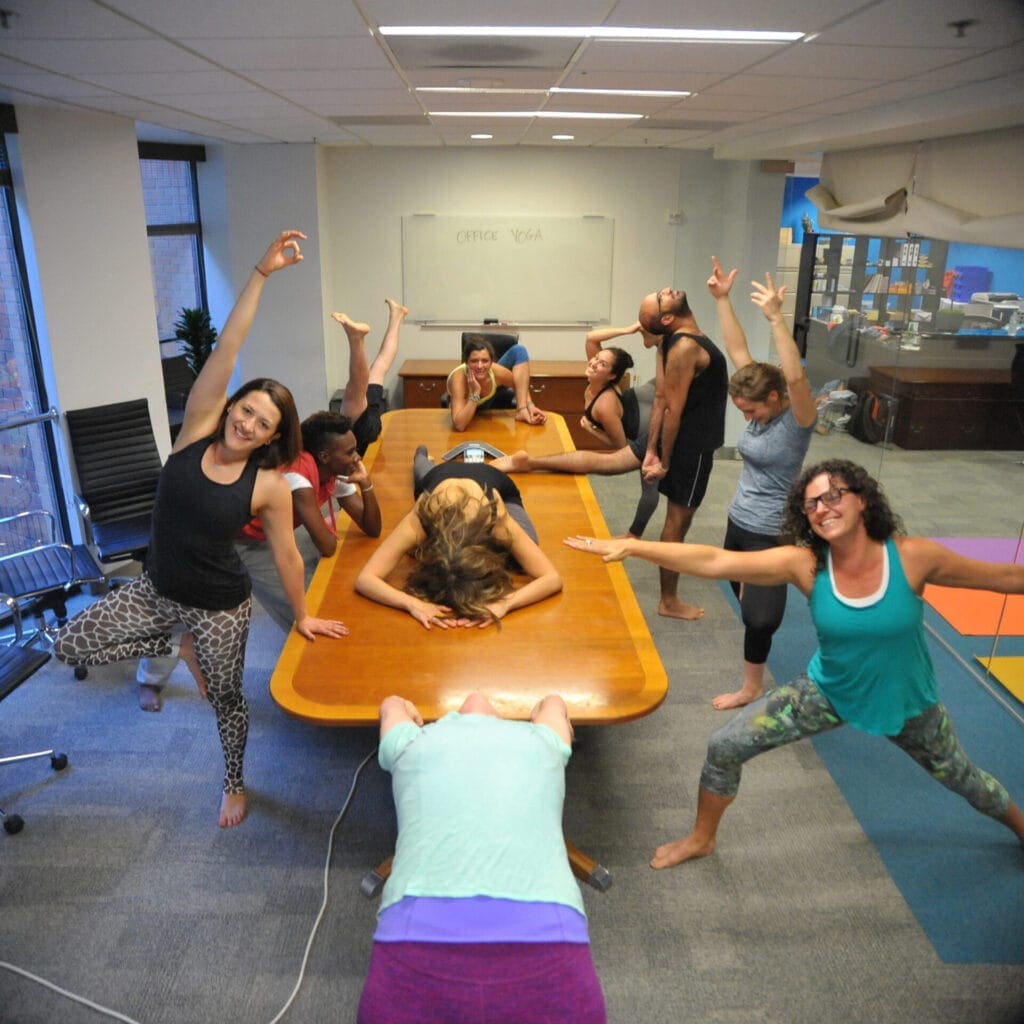Six Tips for Teaching Office Yoga

Office Yoga is becoming more common worldwide, but teaching in a workplace is probably not something your 200-hour or 500-hour YTT prepared you for.
Office Yoga is a practice that incorporates yoga techniques and exercises into the workplace setting. It aims to counteract the negative effects of sedentary office work by promoting physical activity, stress relief, and employee well-being. While the practice of Yoga dates back thousands of years, the specific history of Office Yoga is more recent.
The modern Office Yoga movement emerged in the late 1990s in response to the growing awareness of the detrimental effects of prolonged sitting and a sedentary lifestyle on individuals’ health. With the rise of desk jobs and technology-dependent work environments in the late 20th century, people started experiencing various health issues related to inactivity, such as back pain, poor posture, stress, and reduced productivity.
Office Yoga gained popularity in addressing these issues and provides a convenient solution for employees to incorporate physical activity and stress reduction into their workday. The practice involves adapting traditional yoga postures and breathing exercises to suit the office environment, making it accessible for individuals who spend long hours at a desk.
Teaching Office Yoga requires specific preparation and attention, which is not currently offered in 200-hour or 500-hour Yoga Teacher Training. In 2011, when I started teaching yoga in the workplace, the practice was often referred to as “corporate yoga.” There were no standards for teacher qualification, resulting in an anything-goes mentality. Since then, the industry has rapidly grown — companies and yoga instructors want to bring the practice to more corporate workplaces. However, teaching in an office is very different from teaching in a studio. As Office Yogis, we are responsible for creating a conducive learning environment for employees.
Here are six tips I have our Instructor Training graduates do before teaching an Office Yoga class.

Join Office Yoga Teacher Training
- Clear the space. Move furniture and equipment out of the way. For example, if you’re teaching Desk Yoga around the conference table, move the intercoms, iPads, and other devices out of the way. Wipe down the whiteboards (ask permission to ensure it’s not essential information). This is a practice in sauca or cleanliness.
Make sure cell phones are out of sight. A recent article from the Journal of the Association of Consumer Research has proven “that the mere presence of one’s smartphone may occupy limited-capacity cognitive resources, thereby leaving fewer resources available for other tasks and undercutting cognitive performance.” A clean and clear space is felt. Ask Marie Kondo, who’s made a career out of this concept!
When teaching a flow class, roll out the mats and set up the props for your students. Your students are busy employees who might have to join the class late because a meeting ran late. Setting up their space in advance can make the practice even more accessible. - Dim the lights. Often, the lighting in the office can be harsh on the eyes, especially if employees are lying supine during class. This article on “How Lighting Affects the Productivity of Your Workers” reminds us that “light has an enormous effect on our physical and mental well-being.” Variations in lighting can have an enormous impact on mood. When teaching Office Yoga, turn the lights down or off. If you’re in a conference room, this should be easy to do — turn the lights down to help set a calm, relaxed tone.
- Learn and repeat employee names. Introduce yourself and get to know everyone by name. Class sizes are generally smaller than public classes. As a result, you will see the same students repeatedly.
Forbes shares that “strong social connections make people happier and physically healthier, which can translate into work performance.” This requires teachers to be prepared (cleared space, dimmed lights) and ready to greet the employees when they enter the room. Introduce yourself at either the beginning of class. This is also an excellent time to assess if there are any injuries or medical concerns you should know about. - State your objective. Most employees will be new to the practice of yoga or at least new to your class. It’s essential at this early stage to build rapport. After you’ve learned their names, be clear about your objective for the class. Remind employees what they can expect to gain from being there. Consider keeping the same goal (i.e., “lower back relief”) so students have time to learn. It helps beginners to know what to look for and keeps them coming back when they see measurable progress.
- Start and stop on time. There may not be a clock in the room for you to track time. Wearing a watch is essential to start and finish the class on time. Employees have taken time out of their busy day to do yoga with you, sometimes for just 20 or 30 minutes—every minute counts. Unless the office coordinator asks you to wait, always start the class on time. Finishing on time is even more critical, as often people are racing back to their desks to complete a mountain of tasks. The risk of running over may cause someone to miss a meeting. This breaks the trust in taking future classes, especially if they have meetings scheduled afterward.
- Ditch the Stretch Pants. I hate to say it, so I saved it for last. Office settings have a more conservative dress code than yoga studios. Not to mention, the temperature is cooler, and it gets a bit… nipply. When others see you in yoga clothes, the first thought is, I don’t have stretch pants, or I don’t want to be in yoga clothes in front of my coworkers. It’s best if your appearance reflects the setting that you’re in. In my experience, jeans or black slacks and a scarf go a long way when teaching in the office, especially when teaching the Desk Yoga format.
These six steps are the easy changes to set yourself up for success as an Office Yoga Teacher. Whatever style of yoga you offer employees in the workplace, these six practices can significantly enhance their experience, personally and professionally.
Interested in teaching Office Yoga? Learn more about our comprehensive program for Instructors through our Office Yoga Instructor Training.
